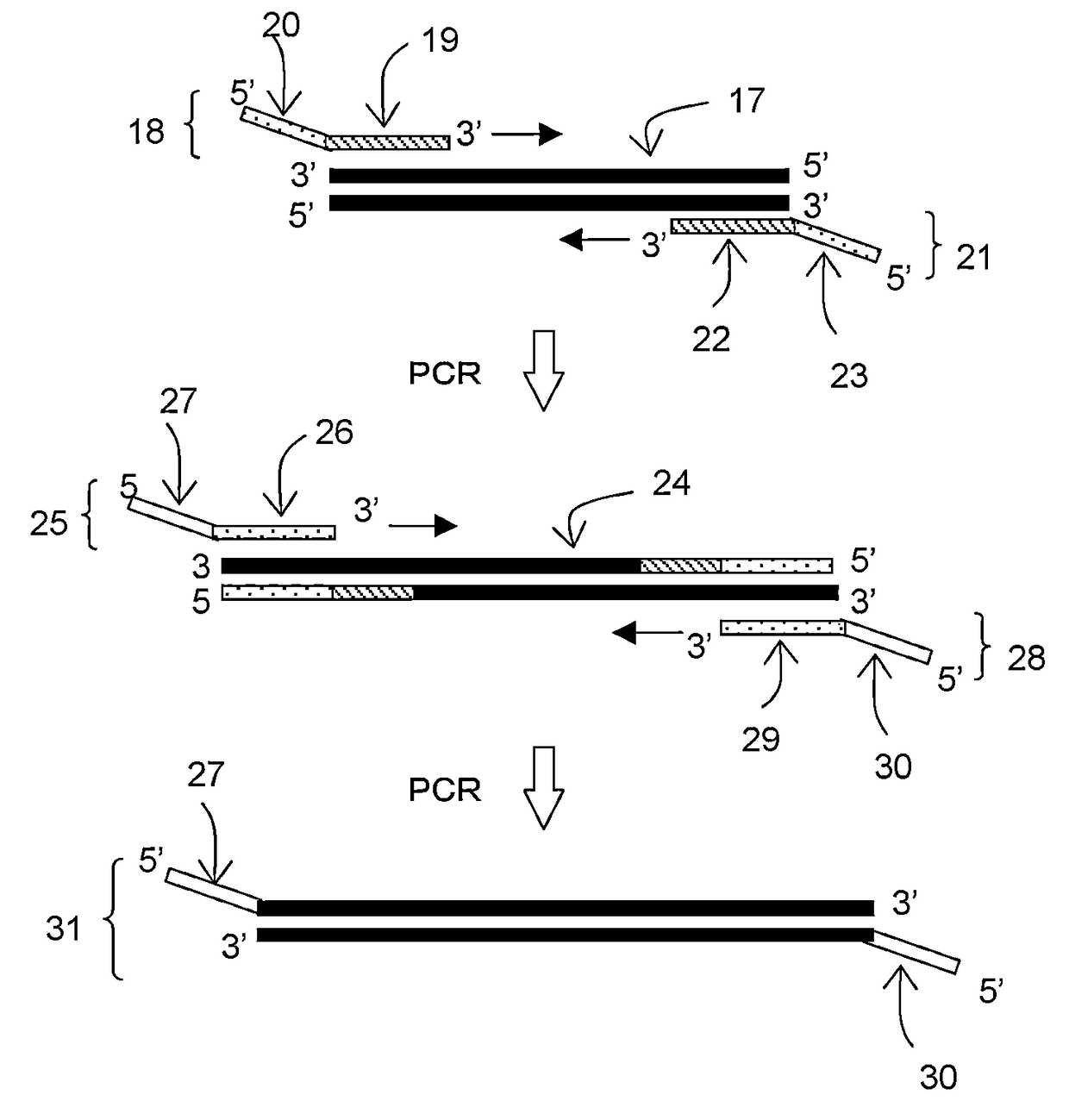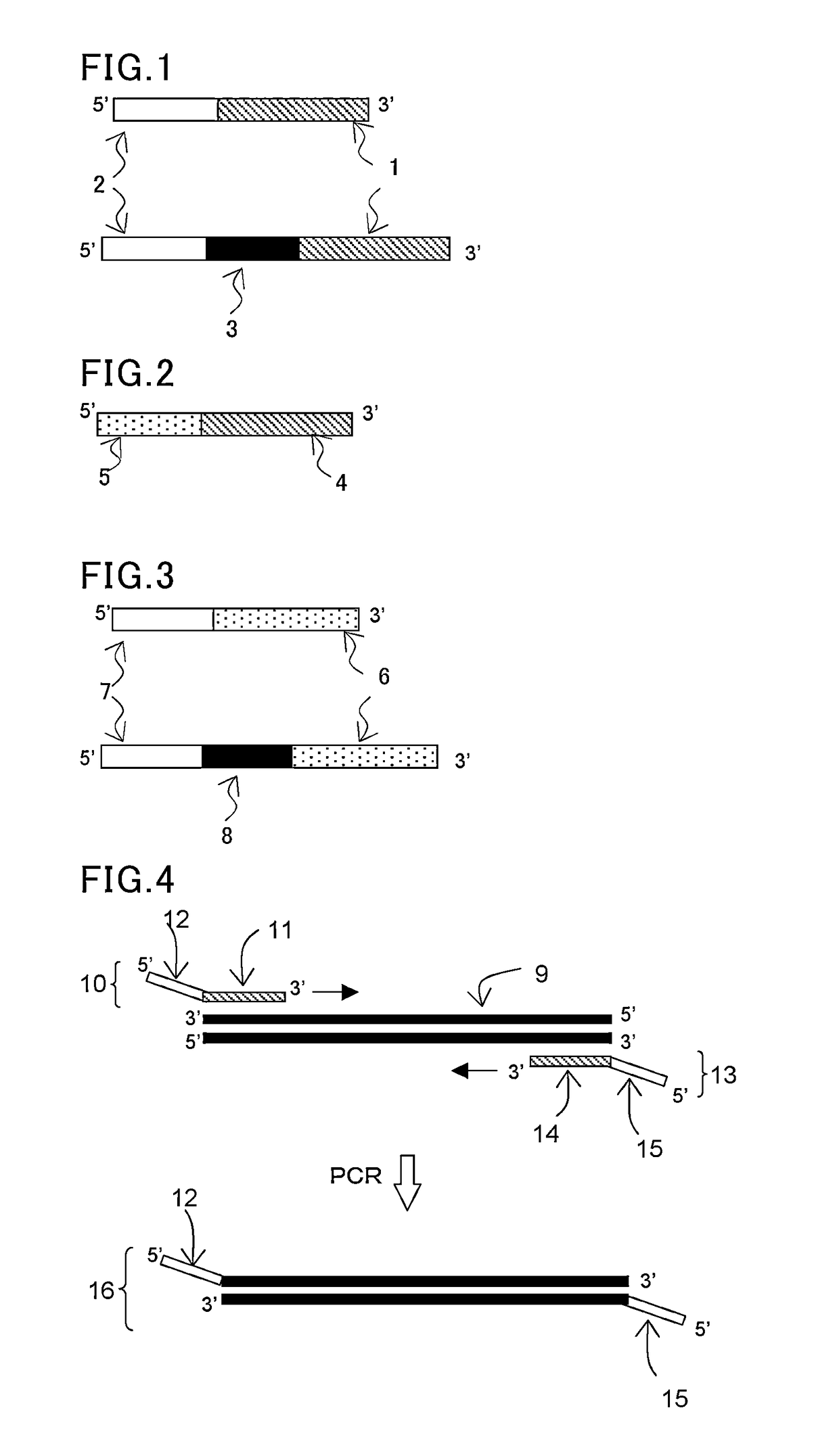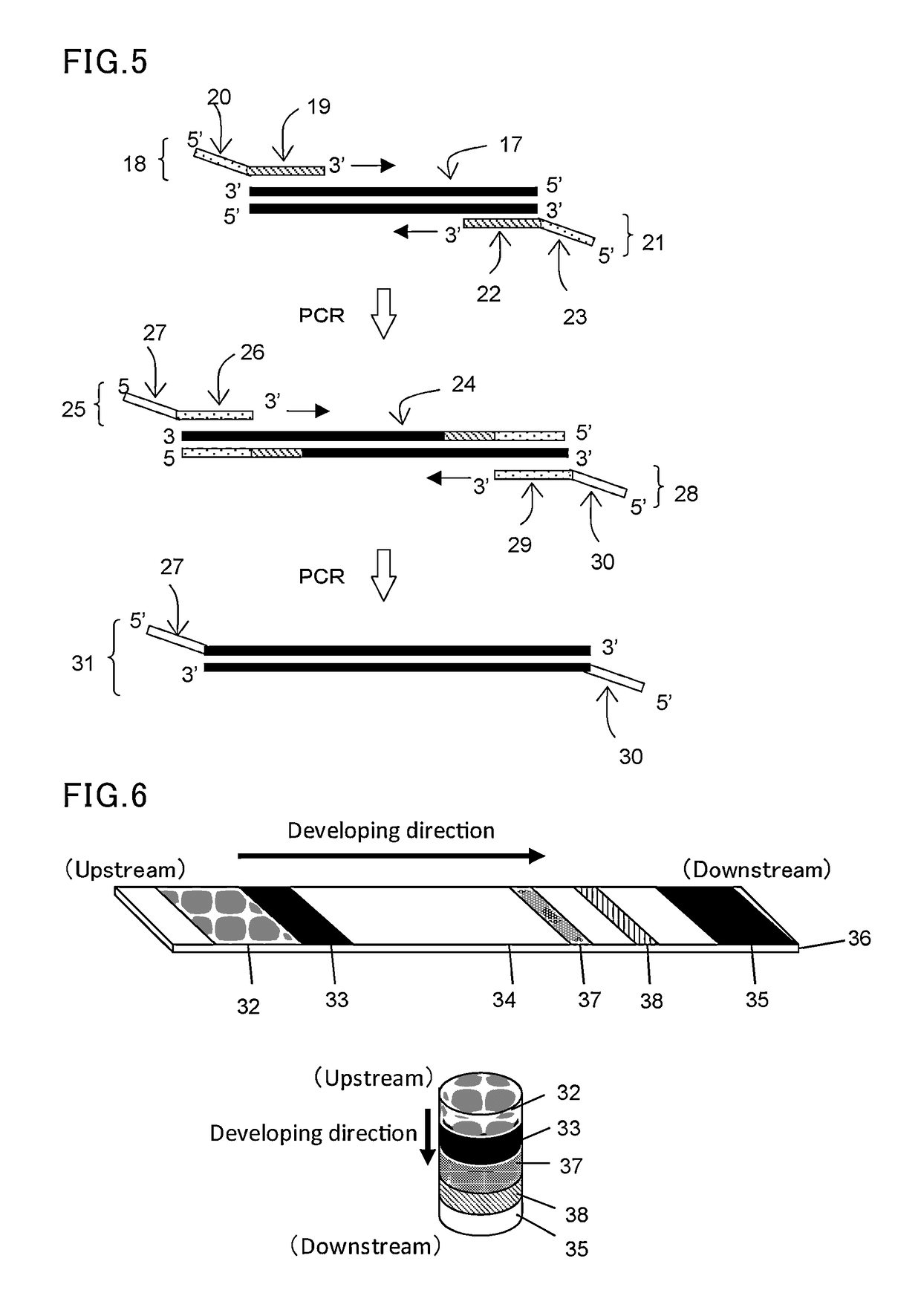Amplified nucleic acid detection method and detection device
a nucleic acid and detection method technology, applied in the field of simple methods for detecting amplified nucleic acids, can solve the problems of increasing the cost of fluorescently labeled nucleic acids, reducing the detection efficiency of amplified dna products, and reducing the number of antigen-antibody or ligand-receptor combinations usable for labeling, so as to improve the detection sensitivity and detection the effect of easy and rapid detection of amplified dna
- Summary
- Abstract
- Description
- Claims
- Application Information
AI Technical Summary
Benefits of technology
Problems solved by technology
Method used
Image
Examples
example 1
(1) Synthesis of L-DNA-Tagged Primers
[0111]In this example, a forward primer (F) and a reverse primer (R) were designed to be able to amplify about 330 base pairs by PCR amplification using pUC19 (available from Takara Bio, Inc.) as a template. Then, tag sequences T1 and T2 which are non-natural (L-) DNA strands were respectively introduced into the 5′ ends of these primers to construct L-DNA-tagged primers T1-F and T2-R. The synthesis of these L-DNA-tagged primers was carried out by a general phosphoramidite method using a DNA automatic synthesizer (H-8-SE: Gene World) with a 0.2 μM column.
[0112]The following shows the primer set prepared in this study.
[0113]
Primer F:(SEQ ID No: 1)5′-Dd(GGAAACAGCTATGACCATGA)-3′Primer R:(SEQ ID No: 2)5′-Dd(CTATGCGGCATCAGAGCAG)-3′Tag sequence T1:(SEQ ID No: 3)5′-Ld(GACAACGGAGACAGAGCCAA)-3′Tag sequence T2:(SEQ ID No: 4)5′-Ld(ATGCTACCGTATGCCCAGTG)-3′Primer T1-F:(SEQ ID No: 5)5′-Ld(GACAACGGAGACAGAGCCAA)-Dd(GGAAACAGCTATGACCATGA)-3′Primer T2-R:(SEQ ID No:...
example 2
(1) Synthesis of Hairpin-Tagged Primers
[0121]In the same manner as in the step (1) in Example 1, a forward primer (F) and a reverse primer (R) were designed to be able to amplify about 330 base pairs by PCR amplification using pUC19 (available from Takara Bio, Inc.) as a template. Then, a polymerase reaction inhibitory region (H) having a hairpin structure and a tag sequence T3 or T4 were introduced into the 5′ end of each corresponding primer to synthesize tagged primers T3-H—F and T4-H—R.
[0122]The following shows the primer set prepared in this study.
[0123]
Polymerase reaction inhibitory sequence H:(SEQ ID No: 9)5′-Dd(AGGCGAGGTCGCGAGCGCACATGTGCGCTCGCGACCTC GCCT)-3′Tag sequence T3:(SEQ ID No: 10)5′-Dd(TATGATATGCTTCTCCACGCATAAT)-3′Tag sequence T4:(SEQ ID No: 11)5′-Dd(TGCTCTGTACACTTGCTCAAT)-3′Primer T3-H-F:(SEQ ID No: 12)5′-Dd(TATGATATGCTTCTCCACGCATAATAGGCGAGGTCGCGAGCGCACATGTGCGCTCGCGACCTCGCCTGGAAACAGCTATGACCATGA)-3′Primer T4-H-R:(SEQ ID No: 13)5′-Dd(TGCTCTGTACACTTGCTCAATAGGCGAGGTCGCG...
example 3
(1) Synthesis of Artificial Nucleic Acid (Azobenzene)-Inserted Primers
[0131]In the same manner as in the step (1) in Example 1, a forward primer (F) and a reverse primer (R) were designed to be able to amplify about 330 base pairs by PCR amplification using pUC19 (available from Takara Bio, Inc.) as a template. Then, a polymerase reaction inhibitory region (X) containing azobenzene (artificial nucleic acid) and a tag sequence T5 or T6 were introduced into the 5′ end of each corresponding primer to synthesize tagged primers T5-X-F and T6-X-R. These two azobenzene-inserted primers were purchased as products custom-synthesized by TSUKUBA OLIGO SERVICE CO., LTD. The following shows the primer set prepared in this study.
[0132]
Tag sequence T5:(SEQ ID No: 16)5′-Dd(TGGCAACATTTTTCACTGGGTTTATAG)-3′Tag sequence T6:(SEQ ID No: 17)5′-Dd(GGTTAGCTTCCAACCACGTGTAGATCA)-3′Primer T5-X-F:(SEQ ID No: 18)5′-Dd(TGGCAACATTTTTCACTGGGTTTATAG XGGAAACAGCTATGACCATGA)-3′Primer T6-X-R:(SEQ ID No: 19)5′-Dd(GGTTAGC...
PUM
| Property | Measurement | Unit |
|---|---|---|
| particle size | aaaaa | aaaaa |
| particle size | aaaaa | aaaaa |
| particle size | aaaaa | aaaaa |
Abstract
Description
Claims
Application Information
 Login to View More
Login to View More - R&D
- Intellectual Property
- Life Sciences
- Materials
- Tech Scout
- Unparalleled Data Quality
- Higher Quality Content
- 60% Fewer Hallucinations
Browse by: Latest US Patents, China's latest patents, Technical Efficacy Thesaurus, Application Domain, Technology Topic, Popular Technical Reports.
© 2025 PatSnap. All rights reserved.Legal|Privacy policy|Modern Slavery Act Transparency Statement|Sitemap|About US| Contact US: help@patsnap.com



